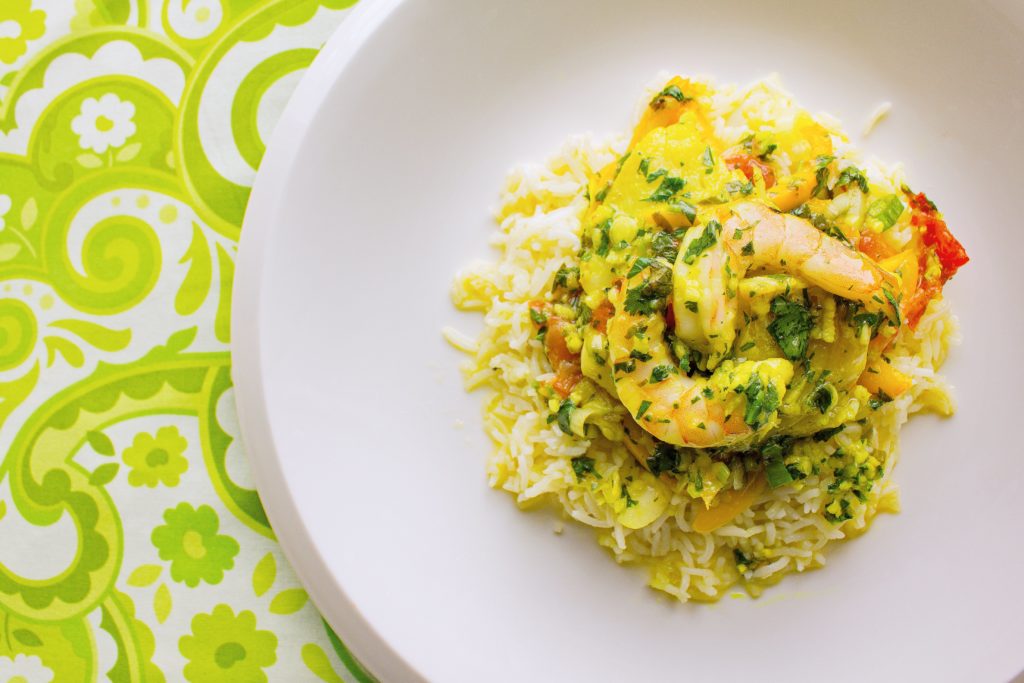Even though she decided to move away at a young age, Carolina Miranda maintains connection to Brazilian roots

Story and food photos by Jasmine Mangalaseril
When Carolina Miranda was about eight or nine, she announced that one day she would move to a country more than 9,000 kilometres from her Brazilian homeland – Canada.
“I just remember a growing feeling. My parents always bought us magazines like National Geographic, so I think I must have seen something, ” recalls Miranda.
“Rio is very similar in landscape to Vancouver, with its big, high mountains by the water. I remember quite clearly the exotic (Canadian) landscape and the wilderness are what attracted me.”
She and her brother had a typical Brazilian childhood. Their mother was a homemaker and their father was an economist and businessperson. Their neighbourhood in Rio de Janeiro’s outskirts had unpaved streets and a night sky bright with galaxies and stars. They later moved to Jundiaí (near São Paulo), a community similar in size and feel to Kitchener and Waterloo.
Everyday dinners were simple: salad, vegetables and meat, served with the Brazilian staple of beans and rice. Weekend barbecues often drew family and friends. Impatient children claimed skewers of grilled chicken hearts while adults tended to big cuts of chicken, beef or sausage.
“Food in my family has always been sacred. We don’t buy things in boxes; the women make it. It’s how we come together: where we learn to love is around the table with our grandmas.
“In Brazil, culture and family histories are passed on from older generations of women to the younger ones, often at the table or in the kitchen.”
While growing up eating and learning to make dishes that were important to her Portuguese maternal grandmother, she learned very little about her maternal grandfather’s story.
A few years ago, Miranda started to piece together his story when she realized his mother (her great-grandmother) was likely a member of a Tupi-speaking nation from Brazil’s northeast. She was part of generations of Indigenous people who were converted to Roman Catholicism and renamed. Her son, being of mixed race, faced the racism and suffered the stigma of being a brown person in São Paulo in the 1940s and 1950s. Since neither of them shared their experiences, and there are few official documents, their stories may not be fully recovered.
Her paternal grandmother, the family matriarch who enjoyed cooking for large family gatherings, lived in Salvador, Bahia.
“Salvador’s very dark, very painful history is connected to Brazil’s slave trade. Now it’s one of Brazil’s strongest cultural capitals because there’s such a mix of flavours and people and colour. Because colonization began more than 500 years ago, those (distinct) threads are not so clear anymore. Many people have mixed, and some have forgotten their roots, like I did.”
Miranda credits cooking one of her grandmother’s dishes, Moqueca (see recipe), with grounding her when her marriage ended.
While making this fish stew with her parents, she realized that while she may not be in Brazil, she could find things that tasted and felt similar to home.
“You share food with the people you love, you share it to show appreciation. I find it’s how much love you put into it, is when food becomes a thing.”
ESTABLISHING CANADIAN ROOTS
Miranda had her first taste of Canada at 16, as an exchange student in Caledonia in the mid-1990s. While she learned as much as possible about her temporary home, she was unprepared for the social realities witnessed during the Caledonia Crisis.
“I was a kid and just arriving; it was so obvious to me, ” she remembers. “At the time I didn’t know my great-grandma was Native (in Brazil). I gravitated to the Indigenous community here, but I didn’t know why. I knew they were struggling, but I couldn’t consciously put it together then. I put it together about four years ago, but when I look back to 1996, it was all intuitive.”
She returned to Brazil wiser but also smitten with Canada. She visited again and immigrated after graduating from university. Marriage followed and she and her then-husband lived in several communities in southwestern Ontario, before settling in Waterloo Region. Connecting with other new Canadians and immigrants – including theatre work with MT Space in Kitchener – helped her find a place in her new community.
After her marriage ended, the mother of two realized she didn’t have access to the female-focused support systems she studied while working on her master’s in education. These readings highlighted how women thrive when they seek out and create networks and circles, ideas that form the basis of Feminine Harbor, which she launched three years ago. This social profit builds women’s social power through shared experiences and storytelling.
“If you think of the world, immigration and diaspora cause women to sever those circles of love and shared traditional stories. Feminine Harbor is a way of creating those circles and tapping into power, too, just by bringing together the family or friends in the community in an organized and celebratory way.”
Its storytelling platform, LIGHT Stories (an acronym for Love, Intelligence, Guidance, Humanity and Trust), is structured similarly to The Moth and TEDx, but centres on the power of women’s experiences. Events take place every three months at the Kitchener-Waterloo Art Gallery and feature four women from diverse communities, ranging in age from their 20s to seniors, each speaking on the evening’s theme. The events attract a broad audience, some of whom relate the paradigms back to their own stories and cultures.
“A man from Zimbabwe came to the one in December and he was deeply moved. He said this is something that feels like home and he never thought he’d see it here.”

MOQUECA RECIPE
Moqueca is a fish stew, developed during slavery in Brazil. Made from ingredients the cook would have on hand, the dish is named for the earthenware pot used to prepare it.
As azeite de dendê (red palm oil) can be difficult to find, turmeric is used to create a warm yellow hue.
This dish is great for those who’ve never cooked fresh seafood before. Just remember: To avoid overcooking the shrimp, you’ll need to remove them from the marinade before cooking the rest. Return the shrimp to the stew for the last few minutes of cooking.
Prep time: 20 minutes plus 20 minutes for marinating
Cooking time: 30 to 40 minutes
Serves: 6 (Recipe can be halved)
For the marinade
4 thinly sliced green onions, green and white parts (about 125 ml or ½ cup)
100 ml (about 6½ tablespoons) crushed or finely minced garlic (2 heads of garlic)
½ bunch finely chopped flat leaf parsley (about 180 ml or 2/3 cup)
½ bunch finely chopped coriander leaf (also called cilantro) (about 125 ml or ½ cup), to taste
125 ml (½ cup) olive oil
10 ml (2 teaspoons) salt
7.5 ml (1½ teaspoons) turmeric
For the stew
700 g (about 1½ lbs.) skinless fresh or thawed firm white-fleshed fish fillets (such as cod, haddock or halibut) cut into 5-cm (2-inch) lengths
500 g (1 lb.) fresh or thawed peeled and deveined shrimp (about 25 jumbo or 30 extra-large)
2 large ripe tomatoes, halved and cut into 5-mm (¼-inch) slices
2 red, orange or yellow bell peppers, sliced into 5-mm (¼-inch) strips
1 large onion, cut into 5-mm (¼-inch) slices
Preheat oven to 200C (400F).
Mix the marinade by combining the sliced green onions, garlic, parsley, coriander leaf, olive oil, salt and turmeric.
Place the fish, shrimp, tomatoes, bell peppers and onions in an oven-safe dish such as a casserole dish, braiser or lasagna pan. Pour the marinade over the fish and vegetables and turn them so they are well-coated. Marinate for 20 minutes.
Remove the shrimp and let them rest in the fridge. Place a lid on the dish or cover tightly with aluminum foil, and cook in the oven until the peppers are soft, about 25 minutes (see notes).
Start cooking the rice (recipe follows).
Once the peppers are soft, add the shrimp on top of the stew, re-cover and cook for another 5 minutes or until the shrimp is cooked. Serve over rice.
Cooking notes
- When done, the fish’s flesh will be opaque and will flake when a fork is inserted into the thickest part and then turned.
- The shrimp is cooked when the flesh has just turned opaque with pink or red on the outside, and they’ve curled into a “C” shape. They will likely be overcooked if they are bright white with pink or red and curled into a tight “O” shape.
- Shrimp placed in the centre of the dish sometimes take longer to cook than those placed closer to the edges. Check the shrimp for doneness after five minutes and remove any that are cooked. If some need more time, keep them in the stew, and return the dish to the oven until they are done.
- This dish tends to take longer to cook if made in a lidded cast iron pan than if made in a Pyrex lasagne pan or ceramic baking dish covered with tin foil.
RICE
Preparation time: 5 minutes
Cooking time: 25 minutes
Serves: 6
3 garlic cloves, crushed or finely minced
½ onion, finely chopped
75 ml (1/3 cup) olive oil
375 ml (1½ cups) long-grain rice
750 ml (3 cups) water
5 ml (1 teaspoon) salt
In a heavy-bottomed saucepan, sauté the onion in olive oil over medium heat until translucent, about 5 minutes. Stir in the garlic and cook until it releases its aroma.
Mix in the rice, pour in the water and add the salt. Keeping the heat on medium, boil uncovered until the water has evaporated/been absorbed, the rice’s surface appears dry, and some steam vents appear. This will take about 8 to 10 minutes.
Lightly mix the rice with a fork, cover the pot, and turn down the heat to low. Cover the pot and let rice steam for 10 minutes.
Remove the pan from the heat and let stand, covered, for 5 minutes.
Fluff the rice with a fork before serving.
This feature appeared in the May-June edition of Grand magazine.
